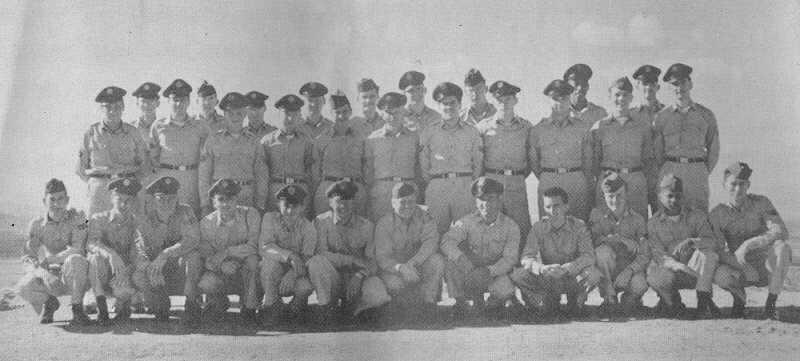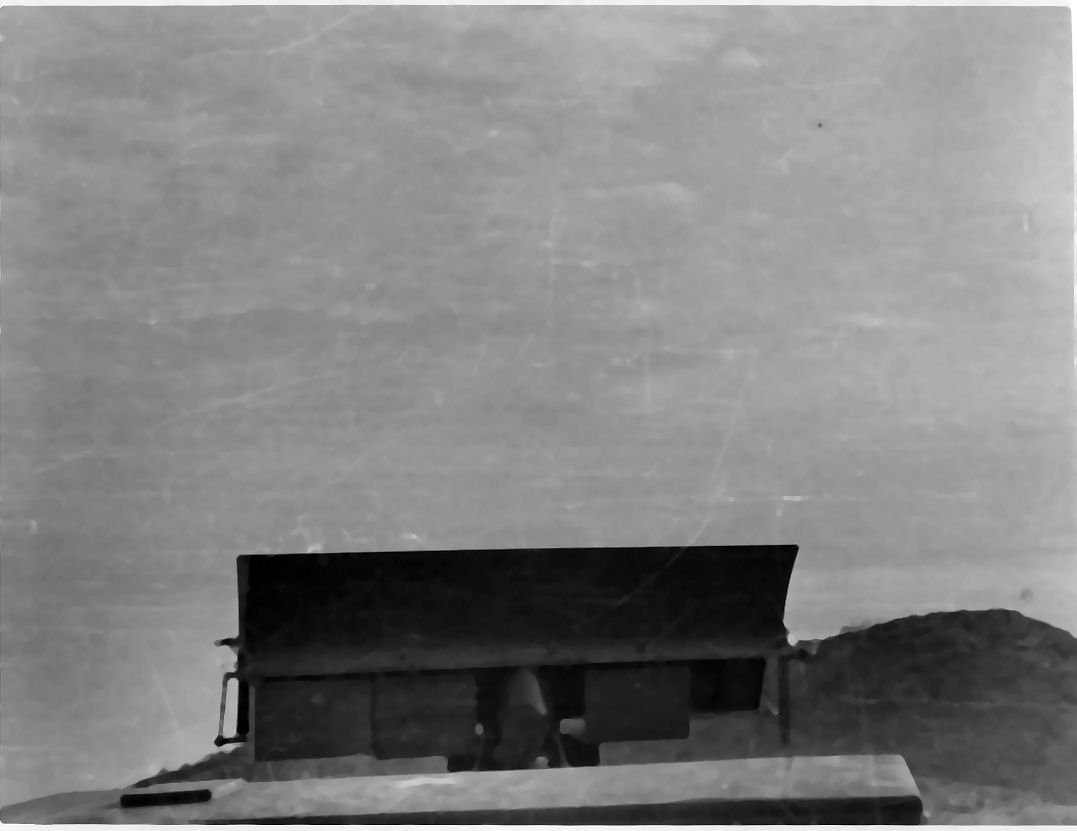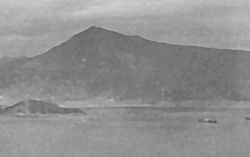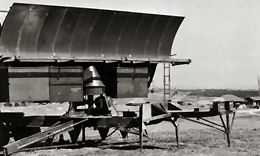The Foundation of Freedom is the Courage of Ordinary People History  On Line On Line
606 AC&W Radar Maintenance Personnel, July 1952 
Front Row:
A/1c J.E. Stoudenmire, A/3cc W.B. Cambell, A/2c R.G. Rupnow, 2/Lt J.E. Shearer, 1/Lt R.J. McKinley, Tech Rep L.G. Kraft, 1/Lt F.L. Edenhart, Tech Rep Bert Kortegaard, A/2c L.G. Josephson, A/b C.I. Muscovalley, A/1c H.E. Wisenhunt | Middle Row:
A/1c R.D. Manley, A/3c B. Nerenberg, T/Sgt J.R. Coleman, A/2c M.E. Keszler, A/3c A.R. Dussault, A/2c M.J. Hudson, A/1c M.C. Vella, A/2c H.L. Tribble, A/2x W.E. Gardiner, A/3c J.G. Bryan, S/Sgt P.E. Kerr | Back Row:
A/2c M.R. Taylor, A/2x D.J. Huff, S/Sgt D.S. Coudriet, A/2c E. Houghes, S/Sgt A.B. Beck, A/3c H.L. Humphrey, A/1c T.J Epkes, A/1c J Lyons, A/1c J.P. Fulton | | |
Earlier1st Lt. Bill Loughlin | Last week I was looking for items about thevarious units I had been with in the Air Corps/Air Force. When I hitthe 606th, there was your article about the "heavy radar" inKorea. Believe it or not, I was able to follow your story after all theseyears. I once "owned" that set.
In March 1949, I returned to the States after flying the "BerlinAirlift". After a leave with my folks in New London, Connecticut, Iheaded for Fairfield-Suisun AFB (now Travis, but that is anotherstory). Anyway, I was told that if I wanted to stay in the Air Force, Ishould be able to do something besides just fly airplanes. Since I hadbecome acquainted with radar in B-24s during the war, I applied to goto Electronics School at Keesler AFB in Mississippi. The course startedon 1 June 1949 and ended on 1 March 1950. The course was broken downinto four week sections with the last few were on radarsets. One of these was the CPS-1 which was mounted on a platformoutside of the school building. There were both written and practicaltests. I remember the practical for the CPS-1. It was to go through thestart-up sequence. Not too hard, except the instructor had a pocket ortwo full of various fuses and tubes which he would supply when we askedfor them. Another part was to trace a pair of wires to find out whatthey did (it was the aircraft red warning lights on the top of theantenna). It was a great school and there were only five of us in the class. I was assignedto the 606th A&W Squadron at Shaw AFB in South Carolina.
The squadron had a modified CPS-1, designated MPS-5 and as far as Iever heard was the one and only. Less than a month after arriving atShaw, I was setting tents up at the local airfield in Fayetteville,North Carolina for "maneuvers". The MPS-5 was disassembled for roadtransport. There was a modified 6 by truck which carried the "sails".The round antenna base was covered with canvas and sort of looked likeit was a canon of some sort as it went down the road. A note, aftereverything was put back together and all the cables and vehicles wereconnected up there was a slight electrical problem. The generators putout 220 volts, 110 to the neutral line. Great, except the neutral lineran about 35+ volts and you discover that if you touched a truck.
I was assigned the TPS-1B and spent most of the time forming a team andlearning the set.
Korea invaded. Begin to box equipment, order supplies, get ready for amove. Between one quarter and one third of the airman technicianstransferred to other radar stations in the US. At he end of August thesquadron headed west to San Francisco by train, still short ofpersonnel. Next by boat to Pusan, Korea. Waited for the equipment toarrive. The MPS-5 was set up on a hill just north of Pusan called "LonePine Hill" for the one tree that grew on it.
Meanwhile the squadron had been given a CPS-5 radar set and had beensent north to Taegu and I had been left behind with the MPS-5, withneither all the equipment, parts or personnel to put it into operation.There was no way any radar data could be used since there were nocommunications and nobody wanted the information. I was told, "Justkeep the antenna turning during the day so that the Army will thinkthey have radar coverage".
Later on, the squadron, with its CPS-5 had moved north to the Anjuarea. That's where the west coast of Korea turns from north to west.There was some talk of moving the MPS-5 up to Wonson on the east coast.Then the Chinese "arrived". The 606th abandoned most of their equipmentand returned to Pusan. After checking all the hills in the area, a 2000foot hill just north of K-9 "Dogpatch" airfield was chosen for the MPS-5 (That's another story)and I was sent west with my TPS-1B which had beenmodified to become a "C" model (another couple of stories).
The squadron and the radar next moved north to P'yontaek. There was anairfield there which was used by T-6 spotter planes. As I remember theradar was set up in a field near the airstrip. I had moved the TPS-1Cto a new site just south of Inchon.
After the fighting had stabilized north of Seoul and the Han River, thesquadron moved the MPS-5 and the rest of the equipment to K-14, Kimpoand "Radar Hill" and that is where it was when you came in. The "callsign" for the squadron was "DENTIST" and my site in Inchon was "DENTISTABLE".
I remained at Inchon until March 18, 1952 when I headed back to the US. |
|  |  | These two pictures were taken in Pusan on "Lone Pine Hill" and sort of go together. The MPS-5 and the height finder are inplace. In the distance is the harbor entrance with part of the "fleet" which was to carry the Marines up to Wonson.
You know the reason, the mines you were involved inremoving. I'm sure you also knew that when the Marines "stormed ashore"they were met by their Commanding General and Bob Hope and his USO Show.
|
 |  | Left is a view in the other direction, to the north. There arethree trucks parked together, two vans and the truck to the right isthe "sail" truck for the MPS-5. The hill/mountain which you see in thebackground was the next site for the MPS-5 and all the equipment whichwent with it. My notes indicate that it was about two thousand feethigh. Right at the base was K-14.
Right is the MPS-5 as it was set up at K-6, P'yongtaek |
|
About the radar site at Anju. Remember I was back in Pusan, running 5thAir Force Rear, that was the official title, and I was just a 1st Lt.When the squadron returned, they didn't talk too much about it, butthis was what little I really learned.
Anyway, to get back to the Anju area. the 8th Army was covering too much front and there was only a ROC Division on their right flank. The Chinese had moved through the hills and mountains and set up road blocks behind the front lines. It all started at the village of Unsan, then back to Kunuri. When the Chinese hit, things fell apart and everyone headed south on what few roads were there. There was only one road between Kunuri and Sunchon and the Chinese road block was waiting. Higher Headquarter had directed them to use that road. Halberstam covers that in his book, "The Coldest Winter." There is an earlier book about the same area by S.L.A. Marshall, "The River and the Gauntlet" which was written in 1987. Very readable. In Halberstam's book there is mention of another route from Kunuri via Anju which they didn't think was blocked, it wasn't, and I suspect that was the route the squadron took from Anju.
I keep wondering what I would have done, if I had been at Anju. I had a similar situation when I had the TPS-1C site south of Inchon. The Chinese had a new offensive and retaken Seoul and plans were being made to evacuate Inchon. By that time I had made some good contacts with the Army in Inchon and was training some of the AAA troops on the radar. I was told that they would have space for my unit should it become necessary. I wanted to stay, my troops wanted to stay, so we did. I sent my Tech Rep south to the squadron because, as I explained, I didn't want to have to write his wife a letter.
Later, when I went back to the squadron, which was located at P'yanteak, the acting commander said he was going to get me for insubordination. I ask, Why? Because you did not move your unit back. My answer, and the end of the conversation, "You never ordered me to move"! Mr. Talbert, noted that while he was in the squadron, the buzz was how brave we were. It was an interesting time, with a Navy cruiser in the harbor firing at the enemy and at night we could see the flash of the guns to the north and east.
I should start out by explainingthat my folk had saved all the letters I wrote home and a few years agoI put them on the computer, adding my own comments here and there. NowI can go back through them and find information and dates. There aretwo references, one on December 24, 1950. "The Major (that would havebeen the C.O. and he was with the squadron at Anju)came back from Japanthe other day. He'd been in the hospital over there for awhile. Someday when I get home I'll tell you the whole story". In a letter datedJanuary 3, 1951 I wrote,"By the way, while Hoskins (another 1st Lt.)andI were holding down things here, part of the squadron was still atTaegu, the main section was at Anju. As you can see by the map, theywere forced to leave in a bit of a hurry and a result left lots ofequipment behind. Everyone got out O.K. and I guess that's whatcounts". I added the following note: "I was told later that it wasnecessary to expend a couple of air strikes (F-80s) against the site,to destroy it before it was captured". I also heard that the 24thInfantry which held that area, had given the squadron something like 12to 24 hours to be out and then someone told them they only had a coupleof hours so they just loaded up and left.
Postscript When I came back from Korea, after a few months of shuffling about, I attended Instructor Pilot School in Selma, Alabama before settling in Ellington AFB in Houston, Texas. Ellington was the training school for navigators and with my radar background, trained as a teacher what better place to send me. When I got there, someone asked me if I wanted to teach or fly? Silly question, fly of course. Well go see Major Youngman. I did and it was Major Jungman and we had been together in the same squadron during the Berlin Airlift and I ended up as an instructor in the instrument flight section. It was heaven, there were B-25s, C-47s, C-45s and T-29s. Some days I would fly three different types. There was always a plane available to fly.
So now you know how I got out of the radar business and back into airplanes.
Causes of the Korean Tragedy ... Failure of Leadership, Intelligence and Preparation
The Foundations of Freedom are the Courage of Ordinary People and Quality of our Arms
Our Sponsors Help Make This Site Possible |
|

